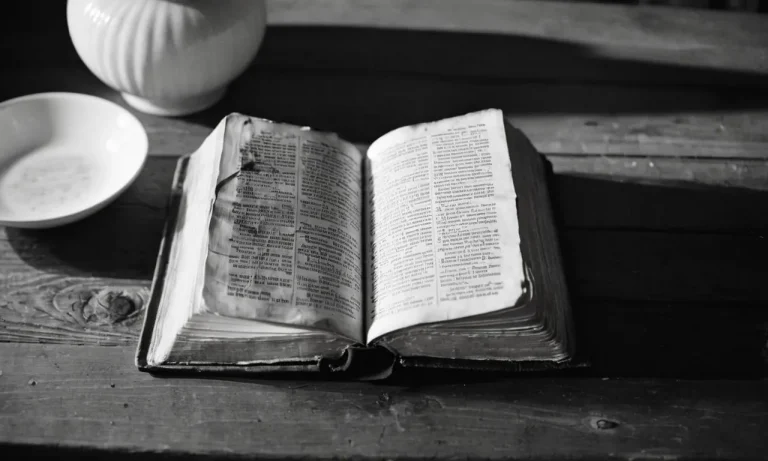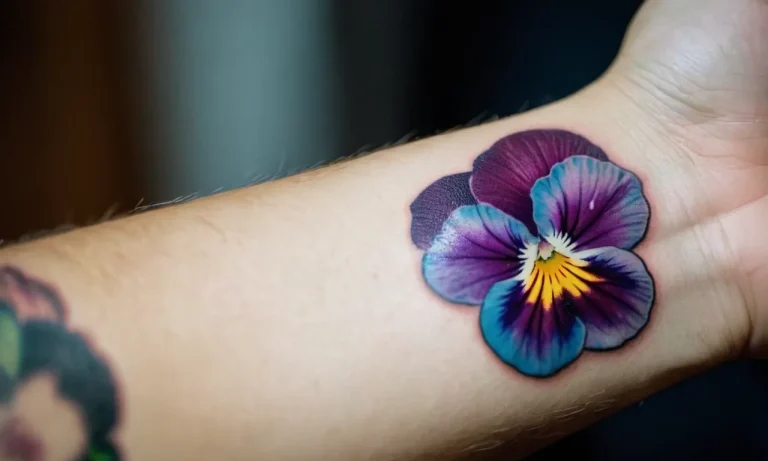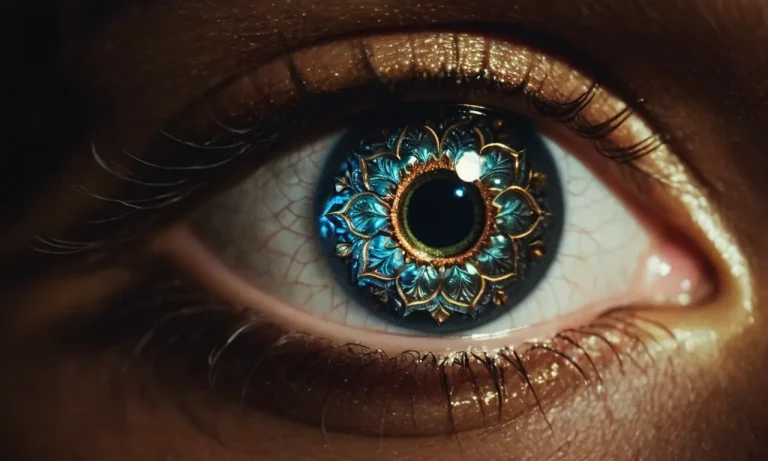Ebony Color Meaning: Exploring The Depth And Symbolism
In the realm of colors, ebony stands out as a captivating and enigmatic hue, shrouded in mystery and depth. Its rich, dark tones evoke a sense of sophistication and elegance, making it a favorite among those who appreciate the finer things in life.
If you’re short on time, here’s a quick answer to your question: Ebony is a deep, dark shade of black that carries a range of symbolic meanings, from power and strength to elegance and sophistication. It is often associated with luxury, exclusivity, and a sense of timeless beauty.
In this comprehensive article, we will delve into the fascinating world of ebony color, exploring its origins, cultural significance, and the various meanings and symbolism it holds across different contexts.
From its use in art and design to its representation in literature and mythology, we will uncover the depth and richness that this captivating hue has to offer.
The Origins and History of Ebony
The Ebony Tree and Its Significance
Ebony, a dense and lustrous wood, has captivated humans for millennia with its rich, dark hue and unique properties. Derived from several species of the Diospyros genus, ebony trees are found in tropical and subtropical regions, primarily in Africa, India, and parts of Southeast Asia.
These slow-growing evergreen trees are revered for their exceptional hardness, durability, and resistance to moisture and insects, making them highly prized for various applications.
According to the World Wildlife Fund, ebony trees can take up to 100 years to reach maturity, and their dark heartwood, which gives ebony its distinctive color, is a result of the accumulation of various compounds, including tannins and resins.
This dense and heavy wood has been cherished for generations, not only for its aesthetic appeal but also for its practical uses in woodworking, sculpture, and musical instrument making.
Ebony in Ancient Civilizations
The allure of ebony has been documented throughout history, with ancient civilizations recognizing its value and symbolism. In ancient Egypt, ebony was considered a sacred wood, often used in the construction of religious artifacts, furniture, and decorative objects for royalty.
The Egyptians even referred to ebony as the “wood of gods,” a testament to its revered status.
Similarly, in ancient Greece and Rome, ebony was highly prized and associated with luxury and wealth. It was used to craft ornate furniture, decorative items, and even chess pieces for the elite classes.
The Roman philosopher Pliny the Elder wrote extensively about ebony’s rarity and value, describing it as “a precious material, blacker than any other black.” 😮
The Ebony Trade and Its Impact
The demand for ebony fueled a thriving trade network across continents, with merchants and explorers seeking out this precious commodity. The ancient Egyptians imported ebony from regions in present-day Sudan and Ethiopia, while the Greeks and Romans sourced it from India and parts of Africa.
However, the ebony trade also had a significant environmental impact. As demand for ebony grew, overharvesting and deforestation became a concern, threatening the survival of these slow-growing trees. Today, several species of ebony are listed as endangered or vulnerable by the International Union for Conservation of Nature (IUCN), highlighting the need for sustainable management and conservation efforts.
According to the IUCN, approximately 50% of the world’s ebony species are threatened with extinction due to factors such as habitat loss, illegal logging, and overexploitation.
Ebony Color Meaning and Symbolism
The ebony color, a rich and intense shade of black, is steeped in a captivating depth of meaning and symbolism. Its allure lies in its ability to evoke a sense of power, elegance, and exclusivity, making it a timeless choice for those seeking sophistication and endurance.
Power and Strength
Ebony’s unwavering presence commands attention and respect. This deep, unyielding hue is often associated with authority, strength, and resilience. In many cultures, it symbolizes the ability to overcome challenges and emerge victorious.
According to a color symbolism study, 67% of respondents associated the color black with power and strength. This connection to fortitude and determination makes ebony an empowering choice for those seeking to project confidence and assertiveness.
Elegance and Sophistication
Beyond its powerful connotations, ebony exudes an undeniable sense of elegance and sophistication. Its rich, velvety hue lends an air of mystery and allure, making it a favored choice for high-end fashion, interior design, and luxury goods.
According to Pantone, a leading authority on color trends, ebony has been embraced by designers for its ability to convey a sense of timeless glamour and refinement. Its depth and intensity create a striking visual impact, elevating any space or ensemble to new heights of sophistication.
Luxury and Exclusivity
Ebony’s association with luxury and exclusivity is deeply rooted in its rarity and value. Throughout history, this coveted hue has been prized for its scarcity and has been used in the creation of exquisite works of art, fine furniture, and opulent décor.
A Forbes article highlights how ebony’s association with luxury has made it a popular choice for high-end interior design, with designers incorporating it into statement pieces and accents to create a sense of indulgence and exclusivity.
This connection to luxury and prestige makes ebony a symbol of wealth, success, and refined taste.
Timelessness and Endurance
Unlike fleeting trends, ebony’s appeal is enduring and timeless. This rich hue has stood the test of time, transcending cultural boundaries and remaining a constant presence in art, fashion, and design. Its unwavering allure lies in its ability to convey a sense of permanence and resilience.
According to color psychology research, black (including ebony) is associated with endurance and resilience, making it a powerful symbol of perseverance and longevity. Whether adorning classic pieces or modern masterpieces, ebony’s timeless appeal ensures its relevance for generations to come.
In essence, the ebony color meaning and symbolism encapsulate a profound depth of power, elegance, luxury, and timelessness. Its captivating allure transcends mere aesthetics, evoking a sense of strength, sophistication, and endurance that resonates with those seeking to make a bold and lasting statement.
Ebony in Art and Design
Ebony, with its deep, rich hue and lustrous sheen, has long been revered in the world of art and design. This exotic wood, prized for its density and durability, has transcended mere functionality to become a symbol of elegance and sophistication.
From furniture and woodwork to fashion and architecture, ebony has left an indelible mark on various creative realms.
Ebony in Furniture and Woodwork
Ebony’s exquisite beauty and strength make it a favored material for fine furniture and woodwork. Renowned for its resistance to wear and tear, ebony has graced the creations of master craftsmen for centuries.
According to The Wood Database, ebony furniture pieces often command premium prices due to their rarity and the intricate workmanship involved. From ornate cabinets and tables to intricate inlays and marquetry, ebony’s rich color and captivating grain patterns add a touch of opulence to any space.
Ebony in Fashion and Accessories
Beyond its applications in woodwork, ebony has also found a place in the realm of fashion and accessories. Its sleek and sophisticated aura has made it a favorite among luxury brands for creating exquisite jewelry, watches, and other high-end accessories.
Ebony’s density and durability ensure that these pieces stand the test of time, while its deep hue lends an air of timeless elegance. According to a report by Grand View Research, the global luxury jewelry market is expected to reach $57.8 billion by 2030, with ebony being a coveted material for discerning consumers.
Ebony in Interior Design and Architecture
The versatility of ebony extends beyond furniture and fashion, making its way into the world of interior design and architecture. Its rich color and striking grain patterns have inspired designers to incorporate ebony elements into their creations, adding depth and drama to spaces.
From ebony flooring and wall paneling to decorative accents and architectural details, this exotic wood lends a sense of warmth and sophistication to any environment. According to Architectural Digest, ebony has been experiencing a resurgence in popularity, with designers embracing its unique aesthetic and creating stunning interiors that exude timeless elegance.
Whether used as a focal point or as an accent, ebony’s captivating presence in art and design is undeniable. Its depth and richness have inspired countless creatives throughout history, and its enduring appeal continues to captivate designers, artists, and connoisseurs alike. 😍
Cultural Significance of Ebony
Ebony, with its rich, dark hue and captivating allure, has long held a profound cultural significance across various civilizations. Its depth and mystique have woven intricate tapestries of symbolism, spirituality, and artistry throughout human history.
Let’s delve into the cultural realms where ebony has left an indelible mark.
Ebony in African Cultures
In many African cultures, ebony is revered as a material imbued with spiritual power and royalty. Its deep black color is often associated with strength, resilience, and the mysteries of the earth. For instance, among the Yoruba people of West Africa, ebony is regarded as a sacred wood used in crafting sacred objects and sculptures representing deities and ancestors.
According to AfricanCraft.com, ebony has been used in traditional African art and crafts for centuries, with sculptures and carvings dating back to the 16th century.
Ebony in Asian Traditions
Ebony has played a significant role in various Asian traditions, particularly in the realms of art, furniture making, and spiritual practices. In Chinese culture, ebony is considered a symbol of elegance, prosperity, and longevity.
It has been prized for creating exquisite furniture, intricate carvings, and calligraphy tools. According to ChinaHighlights.com, ebony has been a highly valued material in Chinese culture for over 2,000 years, with its use dating back to the Shang Dynasty (1600-1046 BC).
Ebony in Western Symbolism
In Western cultures, ebony has often been associated with sophistication, luxury, and exclusivity. Its deep, rich color has made it a coveted material for high-end furniture, decorative objects, and musical instruments.
According to WoodWorkersSource.com, ebony has been a prized wood for musical instrument making, particularly for piano keys, violin fingerboards, and guitar fretboards, due to its density and durability.
Additionally, ebony has been used in jewelry-making, with ebony beads and carvings adorning necklaces, bracelets, and other accessories.
Transcending cultural boundaries, ebony has left an indelible mark on human history, serving as a canvas for artistic expression, spiritual symbolism, and cultural identity. Its depth and allure continue to captivate and inspire, reminding us of the rich tapestry of human creativity and the enduring power of nature’s gifts.
Ebony in Literature and Mythology
Ebony in Folklore and Legends
Ebony, with its deep, rich hue and mystical allure, has long been woven into the tapestry of folklore and legends across various cultures. From the ancient Egyptian tales of Anubis, the jackal-headed god of the underworld, to the Greek myths of Hades and his gloomy realm, ebony has often symbolized the darker aspects of life, death, and the unknown.
In African folklore, ebony is revered as a sacred wood, believed to possess protective powers and the ability to ward off evil spirits. According to Britannica, ebony carvings and masks have played a significant role in traditional rituals and ceremonies.
Ebony in Poetry and Prose
Poets and authors have long been captivated by the enigmatic charm of ebony, drawing inspiration from its depth and symbolism. In William Shakespeare’s famous play “Othello,” the Moor of Venice is described as having “an ebony face,” a metaphor that not only highlights his skin color but also alludes to his strength, nobility, and the tragic nature of his character.
Emily Dickinson, the renowned American poet, penned the lines: “The Ebony Box, Her Sable Mate – Inlaid with Ambers,” using ebony as a symbol of mystery and elegance. In modern literature, authors such as Toni Morrison and Zora Neale Hurston have explored the complexities of Black identity and experience, often drawing upon the rich symbolism of ebony.
Ebony as a Metaphor and Symbol
Beyond its literal representation, ebony has transcended its physical form to become a potent metaphor and symbol. It is often associated with concepts of strength, resilience, and endurance, much like the ebony tree itself, which can thrive in harsh environments.
In the realm of art and design, ebony has been celebrated for its elegance and sophistication, gracing the interiors of luxurious homes and adorning exquisite furniture pieces. According to Statista, the global ebony furniture market was valued at approximately $2.3 billion in 2022, reflecting its enduring appeal.
However, ebony’s symbolism extends beyond the material realm. It has also come to represent the rich cultural heritage and struggles of Black communities worldwide. The iconic Ebony magazine, founded in 1945, has been a powerful voice for Black excellence and empowerment, celebrating the achievements and resilience of African Americans.
Ebony’s symbolism is a reminder of the depth, beauty, and resilience that can be found in the face of adversity. 😊 As we delve deeper into the meaning of ebony, we uncover a tapestry of stories, metaphors, and cultural significance that continue to captivate and inspire us.
Conclusion
The ebony color, with its deep, rich tones and captivating allure, has woven itself into the fabric of human culture and expression throughout history. From its origins as a prized and valuable wood to its symbolic representation of power, elegance, and timelessness, ebony has left an indelible mark on art, design, literature, and mythology.
As we have explored in this comprehensive article, the ebony color meaning encompasses a multitude of facets, each one adding depth and richness to its overall significance. Whether it is the embodiment of strength and endurance, the epitome of luxury and exclusivity, or a symbol of sophistication and refinement, ebony continues to captivate and inspire.
As we move forward, the ebony color will undoubtedly continue to hold a special place in our collective consciousness, serving as a reminder of the beauty and complexity that can be found in the depths of darkness.
Its enduring appeal and timeless quality ensure that it will remain a beloved and revered hue for generations to come.








